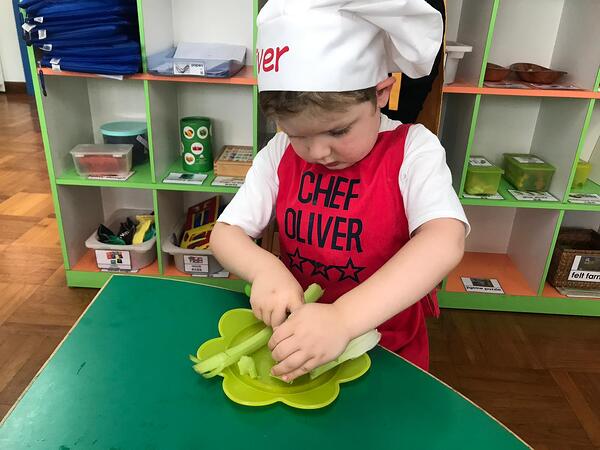Home >
Blog >
How to encourage healthy eating habits for kids
How to encourage healthy eating habits for kids
.jpg)
Apr 22, 2020 5:46:26 PM
Every parent would like their child to adopt a balanced diet and grow into healthy adults. However, with busy schedules it can be challenging to find the time to make healthy meals at home. Adding to these challenges are factors such as fussy eating amongst children and the advertisement of foods containing high amounts of sugar and saturated fat. This blog will explore the importance of a balanced diet for pre-schoolers and provide key tips on how they can adopt healthy eating habits.
THE IMPORTANCE OF HEALTHY EATING AND NUTRITION FOR KIDS
- Optimal growth and development – adopting a diet with the right nutrients is pivotal to fuel growing bodies.
- Brain development – the types of food a child consumes can affect their focus and cognitive skills. Foods such as fish, seeds and oats are shown to improve concentration.
- Lifestyle in later years – adopting healthy eating habits in early years will make it easier children to make healthier choices as an adult.
- Energy – Children learn through play and energy from healthy food is needed to sustain activity. This also aids concentration which is important in the classroom.
- The prevention of diseases – diseases such as Type 2 diabetes, heart disease, high blood pressure as well as obesity can all be prevented by adopting healthier food and lifestyle choices.
- Improve mental health – foods containing certain nutrients e.g. omega-3 fatty acids, vitamin D and magnesium are shown to have positive associations with emotional well-being.

THE HEALTHY FOOD PLATE: WHAT FOODS SHOULD YOU INCLUDE IN YOUR CHILD’S DIET?
The traditional food pyramid is a visual guide that shows the different types and amounts of food that should be eaten each day to stay healthy. The lower the level within the pyramid, the higher the amount of suggested servings:


Download our free guide for child-friendly practical tips on how to stay safe during a pandemic.

However, many have argued that understanding the groups in the pyramid can be complex. Additionally, the pyramid fails to distinguish between healthy foods such as brown rice and fish and less healthy foods such as white rice and sausage within the same category.
The Healthy Food Plate is a friendly and simple visual guide for creating balanced and healthy meals.

It illustrates which foods to eat from the different food groups and in the right amounts, helping to plan portions. The plate is quartered into sections: fruits, vegetables, grains and proteins, with half the plate taken by fruit and vegetables emphasising the importance of incorporating these foods into daily eating. The plate also highlights the importance of drinking water and being active, something the food pyramid did not show.
Click here for more information on the food plate including serving sizes, a grocery checklist, guide to planning and portioning and tips on how to prepare fruit and vegetables: https://www.healthhub.sg/programmes/55/my-healthy-plate
No single food can provide all the nutrients your body needs, it the combination of a variety of foods taken in moderation and at the right balance that helps. This includes:
- Fruit and vegetables: a good source of vitamins and minerals and dietary fibre that can maintain a healthy gut and reduce digestion problems.
- Wholegrains: foods such as brown rice, wholemeal bread and rolled oats contain vitamins, minerals such as iron and zinc and phytochemicals which all help stimulate the immune system.
- Meat and others: foods such as poultry, meats, eggs, seafood and low-fat dairy products form a quarter of the food plate. Two servings of fish per week is recommended. Oil from fish such as tuna and mackerel contain omega-3 fatty acids which help support the heart.
8 HEALTHY EATING TIPS FOR KIDS
- Involve your child in food shopping: a supermarket visit is a great opportunity to teach children about the different food groups and what to look out for in food labels.
- Cook together: involving your child in cooking is not only a great bonding activity, it can also encourage them to try new foods they discover during preparation and cooking.

- Make healthy snacks available: kids are often peckish for something sweet. Keep small bags of fruit and vegetables instead of sweets or air-popped popcorn instead of crisps for these situations.
- Avoid complete restriction - don’t ban sweets entirely, this may lead to overindulging when given the chance. Explain to your child that this is okay when eaten in moderation.
- If your child has picky eating habits, encourage them to enjoy a wider variety of food – g. presenting one new food item at a time (patience is key), making this creative by cutting foods into unusual shapes when serving, making a food collage out of vegetables and serving new foods alongside their favourite foods.
- Lead by example: children learn through imitation. Regularly eating healthy foods around your child can encourage them to explore new foods.
- Disguise the taste of healthier foods – not every child is going to enjoy eating vegetables. Consider mashing vegetables or adding them to a stew. Or could cut up apples and dip them in dark chocolate.
- Use multimedia: there are many songs and rhymes that can help children learn about the importance of nutrition. E.g. the vegetable song, Superdooperfoodalicious, Food Groups are Rockin’ Tonight.
HEALTHY EATING AND NUTRITION AT WHITE LODGE
At White Lodge, we believe in the importance of cultivating healthy eating habits in kids from a young age. This includes celebrations such as Food Revolution Day where children prepare and enjoy healthy meals from around the world. This helps create awareness of the importance of making healthy food choices and understanding the need to source fresh food. Recipes in the past have included vegetarian pasta, oaty fruit cereal and blueberry pancakes.


On Fruity Fridays, children are encouraged to bring a fruit for snack. This is a great way to highlight and reinforce the importance of vitamins and minerals in their diet. Our cookery sessions involve cooking from scratch and a range of ingredients from sustainable sources.
Encouraging healthy eating habits in kids requires a lot of creativity and patience but it has great results for overall health, growth and development. By starting at a young age, children can develop a healthy relationship with food that can last a lifetime.
Change can begin at home, simply by swapping sugary snacks for healthier alternatives and learning to cook a few nutritious meals with the help of your child. It is important to remember to encourage, rather than push, this behaviour. Adopting a healthy lifestyle will not happen overnight but with these tips and the Healthy Food Plate as a guideline, your children will be on the right path to healthy eating.
Need help explaining to your child why is school closed? Download our free child-friendly book to make this a fun and simple activity.


